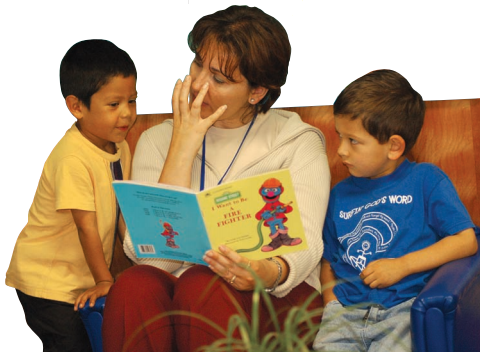8.4: Estudiantes de dos idiomas
- Page ID
- 50231
Un estudiante de dos idiomas (DLL) es el niño que está aprendiendo dos o más idiomas al mismo tiempo, o un niño que está aprendiendo un segundo idioma mientras continúa desarrollando su primer idioma. El término "estudiante de dos idiomas" puede abarcar o superponerse sustancialmente con otros términos de uso frecuente, como bilingüe o multilingüe, aprendiz de inglés (ELL), dominio limitado del inglés (LEP), aprendiz de inglés y niños que hablan un idioma que no es inglés (LOTE) Para ser lo más inclusivo posible, en este libro hemos optado por utilizar el aprendizaje de dos idiomas y el multilingüe en la mayoría de los contextos.
El idioma es esencial para desarrollar un fuerte sentido de cultura y aprendizaje en general. Se ha observado que los niños que aprenden en dos idiomas (DLL) forman un segmento sustancial y creciente de la población preescolar en California. El sesenta por ciento de todos los niños menores de cinco años son aprendices de inglés. Para la mayoría de estos niños, el español es el idioma del hogar, seguido del vietnamita, el cantonés, el hmong, el tagalo, el coreano y otros idiomas ".For the majority of these children, Spanish is the home language, followed by Vietnamese, Cantonese, Hmong, Tagalog, Korean, and other languages.” [107]
Se sabe que más de 200 idiomas se hablan y leen en California, y el español se utiliza como idioma "alternativo" del estado. California tiene más de 100 lenguas indígenas, lo que hace de California una de las áreas lingüísticamente más diversas del mundo. Todas las lenguas indígenas de California están en peligro de extinción, aunque ahora hay esfuerzos para revitalizar el idioma. [108]

Los niños que aprenden en dos idiomas aportan una gran cantidad de habilidades y conocimientos, así como diversos antecedentes culturales a los entornos de la primera infancia; También requieren adaptaciones curriculares para aprovechar al máximo sus habilidades mientras progresan hacia el dominio total del inglés. El conocimiento actual, basado en prácticas exitosas y una investigación sólida, sugiere fuertemente que las estrategias de enseñanza específicas, los enfoques de interacción individualizados y los entornos mejorados son críticos para el éxito a largo plazo de los niños pequeños que no son hablantes nativos de inglés. [110]
Qué programas puedes hacer
El Departamento de Educación de California ha desarrollado los siguientes principios rectores para ayudar a los profesionales en su trabajo con niños que aprenden en dos idiomas:
- Las familias son importantes: la educación de los niños que aprenden en dos idiomas mejora cuando los programas preescolares y las familias forman relaciones significativas. Es a través de estas relaciones que los maestros no solo aprenderán sobre el uso del idioma del hogar, sino también las esperanzas y aspiraciones que los padres tienen para el desarrollo general de sus hijos.
- Reconocer las fortalezas existentes de lenguaje y alfabetización en el idioma del hogar: participar en múltiples prácticas de alfabetización, como leer libros, cantar canciones y recitar poesía, es parte de la vida diaria de muchas familias. Es importante reconocer que los alumnos que aprenden en dos idiomas tienen una variedad de experiencias de alfabetización en su idioma materno que van desde el énfasis en el desarrollo del lenguaje oral hasta las actividades de alfabetización que involucran impresión.
- Respetar los valores y comportamientos culturales reflejados en el lenguaje y la comunicación del niño: el lenguaje y la cultura están altamente integrados, por lo que se debe prestar atención a los valores y comportamientos culturales, que están integrados tanto en el lenguaje y el estilo de comunicación del idioma del hogar como en el nuevo idioma que se está aprendiendo.
Beneficios de mantener los idiomas del hogar de los niños
"Todos los niños se benefician de las ventajas sociales y cognitivas del multilingüismo y la alfabetización múltiple". [111] Los beneficios específicos incluyen:
- Las personas que son multilingües cambian entre diferentes sistemas de idiomas. Sus cerebros son muy activos y flexibles (Zelasko y Antunez, 2000).
- A las personas multilingües les resulta más fácil comprender los conceptos matemáticos, desarrollar fuertes habilidades de pensamiento, usar la lógica, enfocarse, recordar y tomar decisiones, pensar en el idioma, aprender sobre los idiomas.
- Mantener los idiomas del permite que los niños mantengan fuertes lazos con toda su familia, su cultura y su comunidad.
- Los niños multilingües también pueden hacer nuevos amigos y crear relaciones sólidas en su segundo idioma, una habilidad personal importante en nuestra sociedad cada vez más diversa
- Los niños criados en hogares multilingües muestran un mejor autocontrol (Kovács y Mehler, 2009), que es un indicador clave del éxito escolar.
- Las personas que usan más de un idioma parecen ignorar mejor la información irrelevante
- Pensar en un segundo idioma libera a las personas de prejuicios y pensamiento limitado.
Multilingualism is an asset to individuals, families, and our entire society. Early childhood educators can share the benefits of bilingualism with families, find ways to support children’s home languages, and encourage families to keep their language strong. It is important to “make sure families of emergent bilinguals understand the academic benefits and the significance of supporting their child’s home language as English is introduced through the early childhood program, to ensure their children develop into fully bilingual and biliterate adults.”


